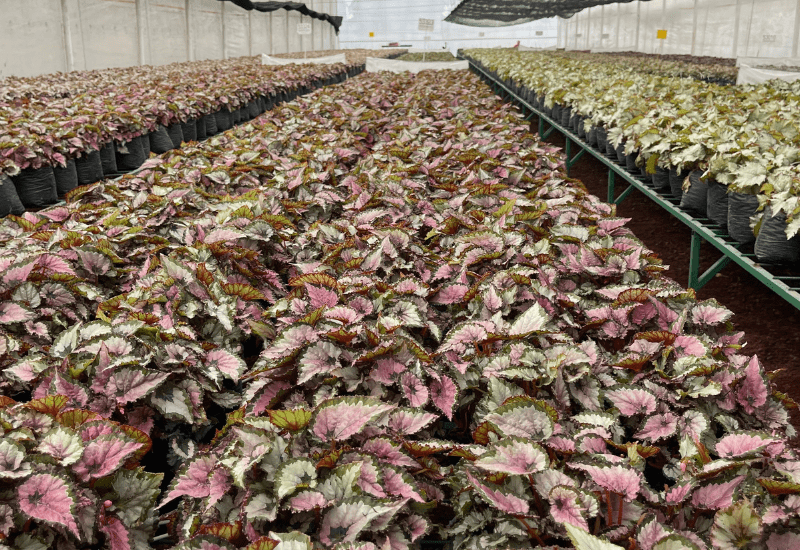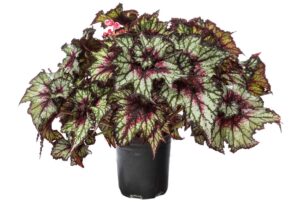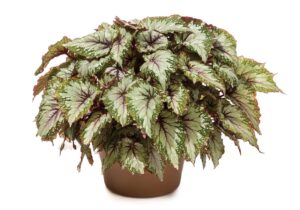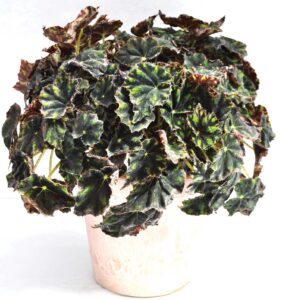
Culture Report: Rex begonia
The foliage market continues to develop in North America. Retailers have consistently increased allowable space for sales and marketing. And, while we have seen the space for display grow, it has predominantly been a green wall of textures that limit impulse purchases.

Begonia, especially Rex types, deliver a color palette unmatched in a single genus. From solid red or white leaves for a holiday display to tricolors that easily grab attention year round, there are options for all occasions.
Green Fuse Botanicals now offers 34 colors among five leaf types, clearly demonstrating the vast options.
Traditionally, Rex begonia was a crop where stock was held in the greenhouse, as the supply chain was limited. Advancement in commercial production has delivered consistent availability in virus clean stock by both vegetative cuttings and tissue cultures. Green Fuse Botanicals, in cooperation with our partners Vivero Internacional, has developed strict protocols to bring unrooted Rex begonia to the market.

The shipping of leaf and stem from tissue cultured stock relieves the worry of diseases typically associated with Rex types, such as xanthomonas. This production method also allows weekly availability to fit the growers finished program, rather than the peak and valleys of tissue culture.
Being rhizomatous, Rex begonias have the ability to store water for several weeks within their root and stem mass allowing for ease of care both at retail and in consumer’s homes.
The Green Fuse Rex program was developed to decrease leaf mass in order to avoid cutting of the leaves during propagation, which will greatly reduce loss from botrytis related issues.

With five complete series in the program ranging from the aggressive Dibs, the cut leaf Bewitched, the “escargot” type swirl leaf in the Curly, the small and numerous leaves of the Love series and well rounded compact Shadow King, there is both a color and habit to fit your program.
Cultural questions on the Rex begonia are the most commonly received by Green Fuse Botanicals. The unrooted shipping protocol has advanced over the years to ensure consistent rooting time. In years past, leaves were sent and the grower would be forced to either stick a curled leaf in loose fill cell packs or cut the leaf to minimize overlap. The development of leaf and stem cuttings allows the propagation team to stick the cutting as they would any other unrooted item. This is key as the grower may choose their own media preference, whether it be loose fill, Elle or glue-based cell.
CROP PLANNING FROM CELL PACKS
 PRODUCTION TIPS
PRODUCTION TIPS
- Leaves will come with a 0.25 inch stem. Stick all leaves facing the same direction. While they will touch, this will reduce the percentage of overlap and allow the media to absorb water instead of shedding off due to leaf mass. A good leaf to media connection is imperative for uniform rooting.
• Apply Pageant fungicide at 6-8 oz/100 g on the day of sticking.
• Apply K-IBA foliar at 250ppm. I recommend this application 2 times for the benefit of accumulation. This can be done on the same day (after drying) or on day 1 and day 2.
• Root zone temperature needs to be maintained at 74-76° F.
• Relative humidity (RH) should be 80-85%. This may be achieved via tenting as well. Begonia Rex are not responsive to heavy media saturation. Using a boom system is not a problem, but should be set to 50% of the saturation compared to traditional spring annuals.
• While supplemental lighting is not required on begonia Rex, it is recommended to speed the rooting process. Day length extension of 16 hours should be considered.
• Roots will become visible in 15-18 days. At this time, the trays may be moved off mist, but should remain in a high heat bench zone.
• Weekly applications of fungicide are recommended due to high RH environment.
• The liners will be ready for transplant in 7-8 weeks from stick. They may be held in a cooler zone if need be. It is imperative to not allow actively rooting liners to drop below an average daily temperature (ADT) of 56° F, as this will stop root and vegetative development.
• Multiple growing points will develop after five weeks, with stem emergence after six weeks.









 Video Library
Video Library 


















